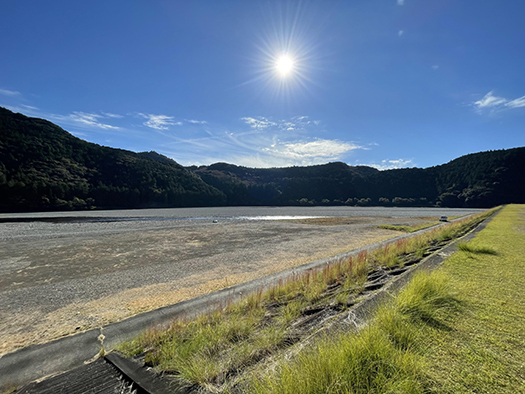

熊野地域は三千六百峰という嶺嶺のさざめきが生み出す空気感が自然のベーシックトーン。奈良・京都からみて聖なる方角・南にあたる紀伊半島。熊野はさらにその南の先端部分を占めている。そういう自然の中を熊野川が貫流している。
この本宮から太平洋への河口にあたる新宮までの熊野川の流域をクルマで走ると、古代の人びとがこの地をかむなび(神奈備)〜神霊が鎮座する山や森〜と捉える心理になったことは、直感的に理解できる。河口に向かって徐々に河川流域左右には柱状節理の赤い壁面が大展開していく光景がとくにこころに迫ってくる。
そして京の都からはるばると険しい山道を踏破してきてその末にこのひろやかな「大斎原」に到達したとき、歴代の皇統たちが深いカタルシスを覚えただろうことも共感できる。
熊野本宮の旧社殿は、この大斎原に展開していた。日本的な縄文由来の自然そのものを神体と考える在来信仰の聖地としてふさわしい。
現在堤防状の領域敷地境界から熊野川までの平面には広大な砂利の空間が広がっている。


熊野川流域に面した山岳からつねに山塊の破片が石砂利となって供給され続けているのだろう。たぶん往古の人びともこの川原の光景に深くこころを癒されたのではないか。仏教思想では、三途の川、賽の河原という空間思想がある。そういう川原が新宮に向かって、ずっとつながっている。まさにこの世とあの世の結界というように捉えることは想起しやすい。
1889年この神殿を大洪水が襲い、神殿建築群は大きな打撃を受けた。
しかしそもそも「蘇り〜よみがえり」を根源的な思想とした熊野では、1年半ほどで近隣の小山に神社建築群を移転させて自ら熊野信仰をよみがえらせた。
しかし本宮社殿の縁起譚解説文などを読み下していたわたしとしては、きのう書いたように奈良県十津川と北海道新十津川のストーリーにこころが満たされて、この大斎原の光景に万感の思いが募ってきていた次第なのです。新十津川町ではいまでも奈良県十津川のことを肉親のように慕って「母村」と呼び続けている。自治体同士でこうした交流は代々受け継がれてきている。
母村からは地元産の木材を利用しての組立て家具椅子を、子村で生まれた子どもたちへの誕生祝いとして送り続けている。子村の親たちはその椅子を組み立てて子どもたちに坐らせ続けている。
災害列島日本社会は、このように数限りなく「蘇り続けた」のだろう。そしてそのなかには万感を込めて「別の地に移る」という選択もあったことは深い叡慮だと思う。
この賽の河原は、大水害で犠牲になった多くの先人たちの鎮魂のようでもある。しかしそこから2,000kmの北海道の地に出発した子孫たちは、みごとに再生を果たしている。本来の熊野信仰とは別のストーリーだけれど、しかし北海道人として、あらたな熊野信仰をいま、わたしたちは生み出し続けているのかも知れないと思い至っているのです。
English version⬇
Kumano Hongu Shrine, Osaibara and “Su – Revival”: A Journey to Kumano and the Myth of the Imperial Family – 13
The “Sai-no-gawara” stretches along the outer edge of Osaibara. It is the boundary of life, but in Kumano, there is a rebirth from there. This is the wisdom of a society in a disaster-stricken archipelago. Wisdom for a society in an archipelago of disasters.
The Kumano area has a basic tone of nature with the air created by the rustling of the 3600 peaks of the mountain range. The Kii Peninsula is in the south, the sacred direction from Nara and Kyoto. Kumano occupies the southern tip of the peninsula. The Kumano River runs through this natural environment.
Driving along the Kumano River from Hongu to Shingu, the mouth of the river to the Pacific Ocean, one can intuitively understand how the ancient people came to regard this land as kamunabi, the mountains and forests where the divine spirits reside. The sight of the red walls of columnar joints gradually unfolding on either side of the river basin toward the mouth of the river is particularly moving.
We can also empathize with the deep catharsis that must have been felt by successive imperial lineages when they arrived at this spacious “Osaibara” after having traversed the steep mountain path all the way from the capital of Kyoto.
The old shrine pavilions of Kumano Hongu were developed in this Osaibara. The site is appropriate as a sacred place for a native religion that considers nature itself, which is of Japanese Jomon origin, to be the deity.
A vast gravel space extends on the plane from the present levee-like area site boundary to the Kumano River.
The mountains facing the Kumano River basin must have been constantly supplying stone gravel from the mountain massifs. Perhaps the people of the past were deeply comforted by the sight of this riverbank. In Buddhist thought, there is the spatial concept of the Sanzu River and the Sai no Kawara. Such a riverbank leads all the way to Shingu. It is easy to imagine it as a boundary between this world and the next.
In 1889, a great flood hit this temple, and the temple buildings were severely damaged.
However, Kumano, whose fundamental philosophy is “revival,” relocated the shrine buildings to a neighboring small mountain within a year and a half to revive the Kumano faith.
However, as I was reading down the commentary on the tale of the origin of the Kumano shrine, I was filled with the story of Totsukawa, Nara Prefecture and Shin Totsukawa, Hokkaido, as I wrote yesterday, and the sight of the Osaibara filled my heart with a deep feeling of compassion. The town of Shintotsukawa still calls Totsukawa, Nara Prefecture “Mother Village,” as if it were a close relative. This kind of exchange between municipalities has been passed down from generation to generation.
The mother village continues to send chairs made of locally produced wood as birthday gifts to the children born in the child villages. Parents in the child villages continue to assemble the chairs for their children to sit on.
The Japanese society of the disaster-stricken archipelago must have continued to “revive” in this way countless times. And I think it is deeply wise that some of them made the choice to “move to another place” with all their hearts.
This Sai no Kawara is like the repose of the souls of many of our ancestors who were killed in the flood. However, the descendants who departed from there to Hokkaido, 200 km away, are making a remarkable comeback. It is a different story from the original Kumano faith, but as Hokkaido people, we have come to realize that we may be continuing to create a new Kumano faith today.
Posted on 1月 15th, 2024 by 三木 奎吾
Filed under: 日本社会・文化研究







コメントを投稿
「※誹謗中傷や、悪意のある書き込み、営利目的などのコメントを防ぐために、投稿された全てのコメントは一時的に保留されますのでご了承ください。」
You must be logged in to post a comment.